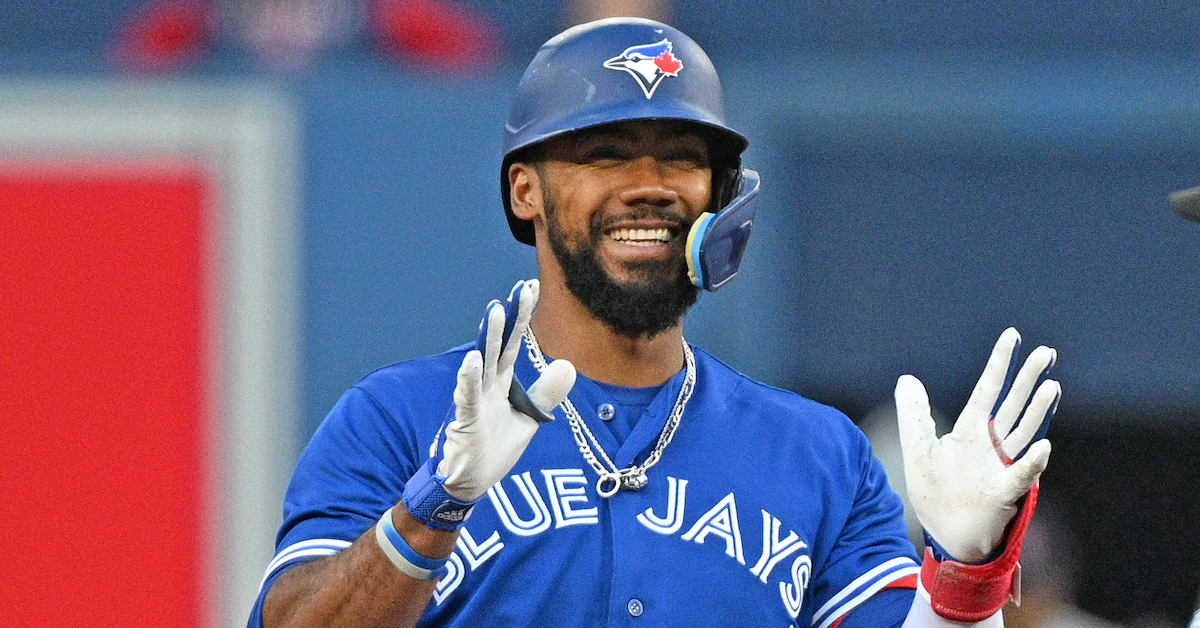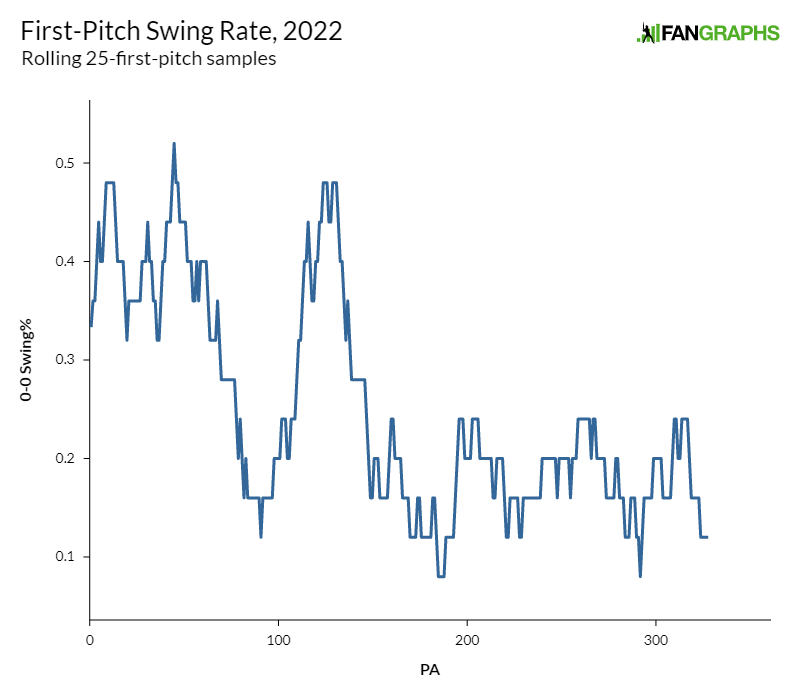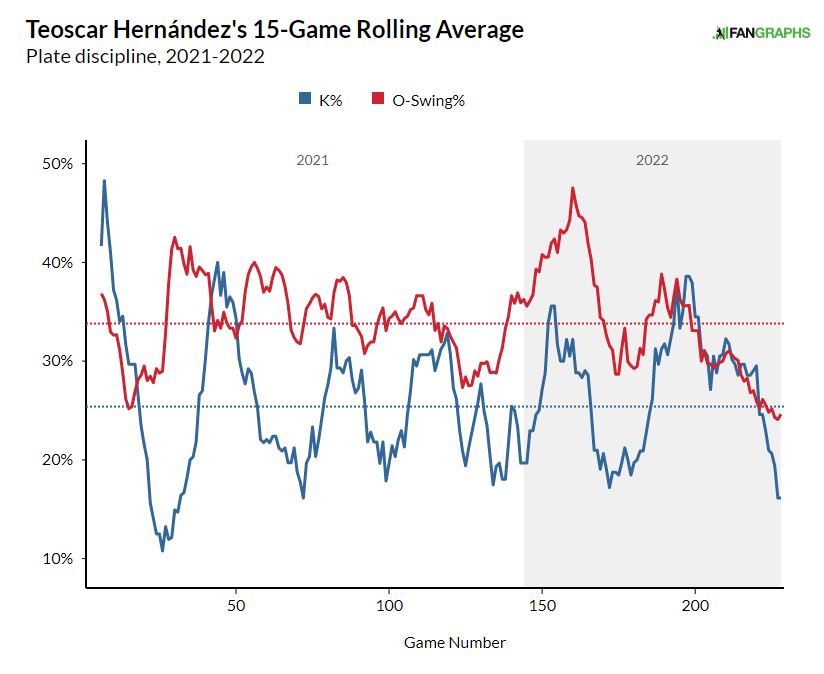Teoscar Hernández Is Changing Plans

If you’re a one-number kind of analyst, Teoscar Hernández is having an unremarkable season. After posting a 132 wRC+ last year, he’s back at it with a 129 mark this year. His overall batting line is down – .274/.326/.495 compared to .296/.346/.524 in 2021 – but between playing all of his home games in Toronto instead of Dunedin and Buffalo and the overall decline in league-wide offense, he’s been roughly the same hitter relative to league average in both years.
If you look at his underlying rates, you still won’t see much difference. Hernández is walking 0.5 percentage points more often this season than last season. He’s striking out 1.4 percentage points more often. He’s running a similar ISO, a similar BABIP, and a similar barrel rate. But zoom in juuust a little bit and things splinter:
| Split | AVG | OBP | SLG | BB% | K% | xwOBA | wRC+ |
|---|---|---|---|---|---|---|---|
| First 1/3 | .229 | .294 | .385 | 6.7% | 24.4% | .324 | 90 |
| Second 1/3 | .286 | .322 | .518 | 5.1% | 31.4% | .359 | 133 |
| Latest 1/3 | .308 | .363 | .587 | 8.0% | 23.0% | .378 | 165 |
Here’s one story you could tell about his season: he scuffled to start the year, made some adjustments that righted the ship somewhat but resulted in too many strikeouts, and finally dialed things in. You wouldn’t even necessarily be wrong; descriptively, those things all happened. Under the hood, though, Hernández made a big adjustment, one you won’t see in that data.
In 2021, he swung at 39.8% of the first pitches he saw; in his career before 2022, he swung at 35.3% of them. In the first two months of this year, he swung at 35% of those same 0-0 pitches. That’s fairly aggressive; over the past two seasons, the league average swing rate on 0-0 counts is 30%. For his career, Hernández was in the 88th percentile among all players in first-pitch swing rate heading into the 2022 season. Then he made a change:

That’s rolling first-pitch swing rate; each data point is 25 plate appearances, starting with his 25th plate appearance of the year. Hernández came into the year as aggressively as ever, and perhaps more so, swinging at between 40% and 50% of opening pitches.
It wasn’t really working for him. Pitchers threw him plenty of junk because they knew he was far more likely than the average batter to swing at something. Get-me-over fastball? Hanging curve right down the middle for a called strike? You can’t do that against aggressive swingers, but you also don’t have to, and pitchers took notice. In 2021, 62% of the first pitches Hernández saw were fastballs. In the first third of this season, that number plummeted to 46%. Want to have a bad time? Take a fastball-hunting approach when pitchers know what you’re planning.
Over the next third of the season (slicing it up into thirds is more for convenience than anything else, but it certainly works well in this retelling), Hernández experimented. He took an extremely passive approach. He went back to swinging aggressively. He tried a little from column A, a little from column B. Finally, he settled on swinging only 20% of the time, give or take. Since the All-Star break, he’s been even choosier, swinging at 15% of first pitches.
The move has paid dividends in a few ways. First, pitchers can’t continue to attack Hernández with breaking pitches and expect to get ahead in the count, so they’ve had to mix more fastballs in. He’s seeing first-pitch fastballs far more often than he did at the start of the year, and that’s driven an increase in results when he does swing. It’s still small-sample-size theater, of course, but loud contact isn’t a bad thing:
| Split | Batted Balls | wOBA | xwOBA | Barrels |
|---|---|---|---|---|
| First 1/3 | 13 | .282 | .366 | 3 |
| Second 1/3 | 10 | .383 | .267 | 1 |
| Latest 1/3 | 7 | .548 | .577 | 1 |
What’s more, Hernández has cut down on his chases significantly. In the first third of the season, he chased 16 plate appearance-opening pitches. In the middle third, he chased four. Since July 6 (the most recent third of the season), he’s chased exactly one pitch on 0-0. I don’t really blame him for this one:
His behavior on first pitches is a microcosm of his behavior overall. Take a look at his swing rates by zone, excluding two-strike pitches where the count incentivizes an aggressive defense of the zone:
| Split | Heart | Shadow | Chase | Waste |
|---|---|---|---|---|
| First 1/3 | 58.8% | 44.1% | 8.5% | 0.0% |
| Second 1/3 | 46.2% | 31.8% | 11.1% | 0.0% |
| Latest 1/3 | 47.5% | 32.6% | 9.1% | 2.1% |
The tradeoff is clear. Hernández is swinging at fewer pitches over the heart of the plate, and in exchange he’s swinging at fewer pitcher’s pitches, those in the “shadow zone” around the edges of the strike zone. I wouldn’t normally recommend that swap for everyone, but for Hernández, the tradeoff has been working. Despite a slightly diminished swing rate on the best pitches to offer at, he’s among the league leaders in production over the heart of the plate. In exchange, he’s shored up what was the weakest part of his game last year, his propensity to go after marginal pitches and take himself out of at-bats.
It’s not quite as simple as that. Pitchers have agency, too, and they can adjust their approach based on what Hernández is doing. They’re going to have to. In the past, running a high strikeout rate was simply a cost of doing business for him; combining an aggressive approach at the plate with below-average contact numbers means that he’s always going to run into occasional clumps of empty plate appearances. That hasn’t stopped him from being a valuable hitter, but it has been a headwind.
Right now, it looks like that headwind might be lessening. Take a look at a 15-game rolling chart of his strikeout rate:

That’s a terrifying chart for Blue Jays opponents, because Hernández’s power on contact isn’t going anywhere. His walk rate hasn’t budged, either. It’s not sterling by any means, but this isn’t a case of him lowering strikeouts through sheer Astudillo-esque aggression. It’s just a new approach. Want another way of looking at it? We already covered Hernández’s newfound ability to lay off tough pitches. Let’s add chase rate to the graph:

It’s all tied together. Fewer swings at borderline pitches means fewer chases, which means fewer strikeouts, which means pitchers have to bite the bullet and challenge him more often. The next logical step for pitchers in this dance would be to amp up their first-pitch aggression and get ahead in the count; after all, Hernández has specifically toned down his aggression there. But does anyone really want to pump fastballs over the middle of the plate to one of the best fastball hitters in baseball?
That might be the right decision in the long run. Heck, in the long run, Hernández might start swinging more even without pitchers doing anything. Perhaps he’s just having a great month, and he’ll revert to his former approach by year’s end. Maybe it’s a bluff, and he’s already decided to start swinging aggressively again no matter what pitchers do.
But if Hernández has leveled up, if he suddenly becomes hard to strike out in addition to showing prodigious all-fields power, you’ll know why. First, he reined in his first-pitch approach. Next, he made a conscious effort to pare back on swinging at borderline pitches, even if it meant letting a few more good ones go by. I don’t know what comes after that, but I do know that Toronto’s AL East opponents won’t be happy that Hernández was able to take what looked like a down year in May and turn it into an opportunity for improvement.
Ben is a writer at FanGraphs. He can be found on Bluesky @benclemens.

Good stuff.